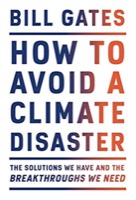Book notes: How to Avoid a Climate Disaster
Jun 22, 2021
By Bill Gates.
Bill McKibben panned this book in a nytimes book review, so I was going to give it a miss until my sister read it and found quite a bit to like. I had noticed it available in the “peak picks” section of the Ballard Library so I picked one up. (Out of a stack of 10 copies, another bad sign for the planet.)
Main takeaways:
- Eyes on the prize: Globally we emit 51 tons of carbon dioxide equivalents per year. Must get to zero for rich countries by 2050, and poorer countries shortly afterwards.
- If we don’t act it will likely be catestrophic in our lifetimes.
- It will take government policies, business engagement, and personal behavior changes to solve.
- There are many sources of emmissions and we have to solve all of them.
- Bill Gates came about this problem from a world-poverty point of view, and spends most of his energy on helping poorer communities adapt to climate change.
- He’s pretty funny. For me there were about 0.5 LOL moments per chapter. My favorite was him discussing with Melinda how many times one can appropriately use the word “fart” while talking about cow methane emissions. (p117)
Five questions when considering solutions: (Chapter 3, p52)
- How much of the 51 billion tons does it solve?
- What’s your plan for cement?
- How much power are we talking about?
- How much space do you need?
- How much is this going to cost?
The main sectors for greenhouse gas contribution: (p55)
- Making things: 31%
- Plugging in: 27%
- Growing things: 19%
- Getting around: 16%
- Keeping warm and cool: 7%
What each of us can do: (Chapter 12, p218)
- As a citizen:
- Engage with government (letters, discussions), locally and nationally.
- Run for office.
- As a consumer:
- Sign up for green pricing with your local utility.
- Reduce your home’s emissions. (heating, cooling, insulation, smart thermostat)
- Buy an electric vehicle.
- Try a plant-based burger.
- As an employee or employer:
- Several things listed here but basically be mindful of low-carbon options.
Little tidbits of stuff that I learned:
- There is a Direct Air Capture faciilty in Switzerland. Currently $200/ton. $100/ton is doable. That’s $5.1 trillion/year. Hard to collect that much money, and not clear that we could do this for all emissions that we emit at the moment. We can’t get there with DAC alone. (p64)
- If you build a reservior on carbon-rich soil, it can leach methane that makes the dam a worse emitter than a coal power plant for 50-100 years. (p69)
- Plastics aren’t so bad from a climate change persepective… it will take hundreds of years for the carbon to escape. (p105)
- Think of the cost of solutions as a “green premium” (see table on p107).
- Cement is a difficult problem. You can’t avoid creating carbon dioxide when you make cement. “Limestone plus heat equals calcium oxide plus carbon dioxide.” (p109).
- Gasoline is cheaper than bottled water. (p130)
- The best lithium ion batteries are 35 times heavier than gasoline. Planes, heavy trucks, and large ships will likely never run on batteries. Must have biofuel, ~100% green premium. (p140 - 144)
- Some solutions already have negative “green premiums” like heat pumps. (p154)